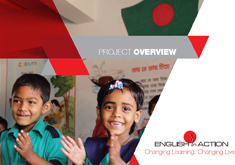Minu Begum was an ambitious child who always wanted to teach, and her perseverance and hard work has made her a prominent English teacher in Lalmonirhaat, Rangpur.
She comes from a small village around the great Teesta River. Across her upazila, she is renowned as an EIA teacher—because in her classes students smile, enjoy themselves and want to learn!
Back in 2009, 5 years ago, she was one of the first batch of teachers who followed the EIA programme. She is among those teachers from the pilot phase of the project, who imbued the strength of the EIA project and turned it into something special through their own enthusiasm and industry, proving that what EIA has brought to the classroom for children and for teachers’ professional development works. Tales of the impact of these initial teachers across 24 upazilas built a strong argument for EIA to go large scale with its innovative approaches.
At exactly the right moment in her teaching career, EIA added in some extra ingredients to help Minu excel—authentic classroom video, audio materials and peer support. In the pilot phase EIA provided a logitec speaker and an iPod mini. At that time, back in 2009, it was impossible to show video on an accessible feature phone, so the iPod mini offered the project the opportunity to trial the concept. Once the mediated video delivered through mobile technology was proved a success and the sophistication of the Nokia feature phones grew, the iPod was replaced by affordable Nokia phones during up-scaling.
And now 5 years after the initial 16 months programme with EIA, she continues the classroom practices she encountered through the videos and offers support to other teachers thus building a teachers’ community of learners.
“The practices which EIA trained me with are improving my teaching style and students are learning. I believe in EIA and I continue to practise it”, says Minu Begum.
The story of Minu Begum and many teachers like her, proves that EIA learning and teaching methods are sustainable, as they are not only changing classroom practices but changing the perceptions of English language learning, building teachers’ confidence and engaging students.






